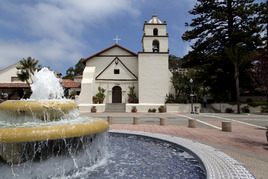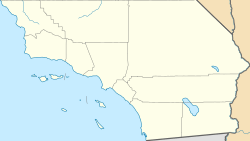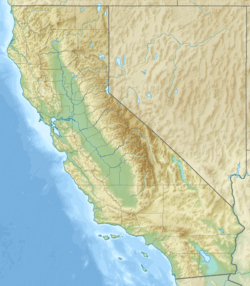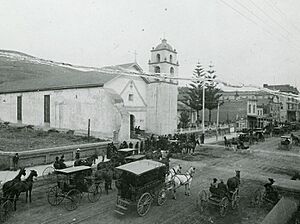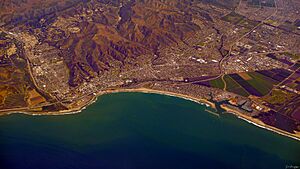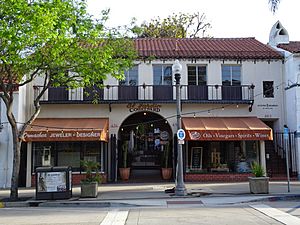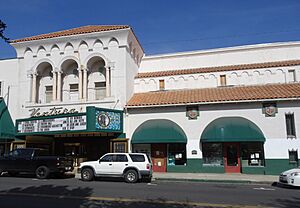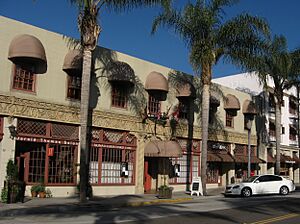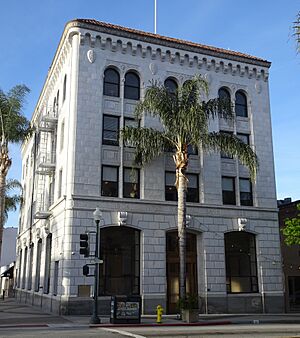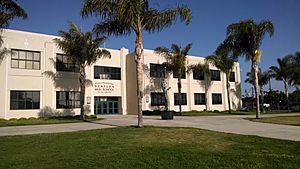Ventura, California facts for kids
Quick facts for kids
Ventura, California
|
||
|---|---|---|
| San Buenaventura | ||
|
||
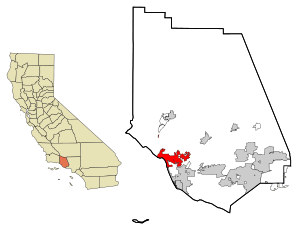
Location in Ventura County
|
||
| Country | United States | |
| State | California | |
| County | Ventura | |
| Mission | March 31, 1782 | |
| Incorporated | April 2, 1866 | |
| Named for | Saint Bonaventure | |
| Area | ||
| • Total | 32.29 sq mi (83.63 km2) | |
| • Land | 21.89 sq mi (56.68 km2) | |
| • Water | 10.41 sq mi (26.95 km2) 32.53% | |
| Elevation | 36 ft (11 m) | |
| Population
(2020)
|
||
| • Total | 110,763 | |
| • Rank | 4th in Ventura County 62nd in California |
|
| • Density | 3,430.3/sq mi (1,324.44/km2) | |
| Demonym(s) | Venturan | |
| Time zone | UTC−8 (Pacific) | |
| • Summer (DST) | UTC−7 (PDT) | |
| ZIP codes |
93001–93007, 93009
|
|
| Area code(s) | 805 | |
| FIPS code | 06-65042 | |
| GNIS feature IDs | 1667934, 2411779 | |
Ventura, officially called San Buenaventura, is a city in Ventura County, California, United States. It is the main city of the county. Ventura is a coastal city located northwest of Los Angeles. In 2020, about 110,763 people lived there. Ventura is a popular place for tourists because of its old buildings, beautiful beaches, and fun resorts.
People have lived in Ventura for at least 10,000 years, including the Chumash people. Spanish missionaries arrived in 1782 and built Mission San Buenaventura. This mission gave the city its name. Later, in 1866, San Buenaventura became an official city. In the 1920s, a big oil boom helped Ventura grow a lot. This growth continued after World War II.
Contents
- Ventura's History: A Journey Through Time
- Ventura's Location and Environment
- People of Ventura: Demographics and Community
- Ventura's Economy: How People Make a Living
- Arts, Culture, and Fun in Ventura
- Sports and Recreation in Ventura
- Learning in Ventura: Schools and Colleges
- Ventura's Infrastructure: Getting Around and Utilities
- Ventura's Neighborhoods
- Famous People from Ventura
- Sister Cities
- See also
Ventura's History: A Journey Through Time
Who Lived in Ventura First? The Chumash People

Long, long ago, about 10,000 to 12,000 years ago, people first lived in the Ventura area. The Chumash people were one of the main groups. They lived along the coast of California for a very long time.
Archaeologists have found many tools and items from the Chumash culture. The Chumash village of Shisholop was located where Figueroa Street is today. The Chumash were skilled sailors and used large canoes called Tomol. They traded things from the sea and land with other Chumash people on the Channel Islands.
When Did the Spanish Arrive in Ventura?
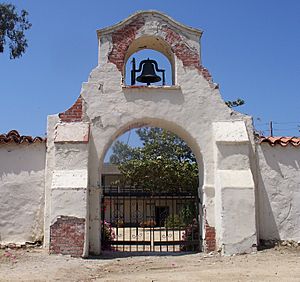
In 1769, Spanish explorers first came to this area. A missionary named Fray Juan Crespi wrote that they saw a large, well-planned town. This was a Chumash village.
In 1782, Junípero Serra founded Mission San Buenaventura. This was his ninth and last mission in California. The mission was named after Saint Bonaventure. The first mission building burned down in 1801. A new one was finished in 1809, but an earthquake damaged it in 1812. The mission was rebuilt and is still used as a church today.
What Happened During the Mexican Era?
After Mexico became independent from Spain in 1821, the mission lands were given away. These large areas were called ranchos. Downtown Ventura was part of a big rancho called Rancho Ex-Mission San Buenaventura.
In 1838, a battle called the Battle of San Buenaventura took place here. It was between different groups from northern and southern California. The Olivas Adobe, a beautiful old house, was built in 1841 on one of these ranchos.
How Did Ventura Become Part of the United States?
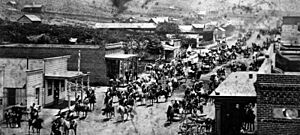
After the Mexican–American War, California became a U.S. territory in 1848 and a state in 1850. More settlers came to Ventura. They bought land or settled there.
The Ventura Pier was built in 1872. It cost $45,000 and was the longest wooden pier in California. It was rebuilt after a big storm in 1995.
In 1919, the large Ventura Oil Field was discovered. This led to a huge growth in Ventura in the 1920s. Many new buildings were constructed, like the Ventura Theatre (1928) and the First Baptist Church of Ventura (1926). Oil companies even sponsored local sports teams.
In 1928, the St. Francis Dam broke, causing a huge flood. More than 600 people lost their lives as the water rushed down the Santa Clara River to the ocean.
In 1959, the Ventura Freeway (U.S. Route 101) was completed. This made travel to Los Angeles much easier.
In 2017, the Thomas Fire started nearby and spread into Ventura. It burned down over 500 homes in the city.
During the COVID-19 pandemic in 2020, Main Street in downtown Ventura was closed to cars. This helped businesses and kept people safe.
Ventura's Location and Environment
Ventura is on the California coast, northwest of Los Angeles. The city stretches along the Ventura River. This area has steep hills on both sides. The eastern part of the city is on a flat coastal plain. The Santa Clara River forms the southern border of the city.
Ventura is in an area where earthquakes can happen, like much of California. The Ventura Fault could cause a large earthquake and even a small tsunami. The city covers about 32.1 square miles (83.1 square kilometers). About 21.7 square miles (56.2 square kilometers) is land, and 10.4 square miles (26.9 square kilometers) is water.
What is Ventura's Climate Like?
| Weather chart for Ventura, California | |||||||||||||||||||||||||||||||||||||||||||||||
|---|---|---|---|---|---|---|---|---|---|---|---|---|---|---|---|---|---|---|---|---|---|---|---|---|---|---|---|---|---|---|---|---|---|---|---|---|---|---|---|---|---|---|---|---|---|---|---|
| J | F | M | A | M | J | J | A | S | O | N | D | ||||||||||||||||||||||||||||||||||||
|
3.6
67
44
|
3.8
67
45
|
2.8
67
47
|
0.9
69
48
|
0.3
71
52
|
0.1
73
56
|
0.1
76
59
|
0.1
77
58
|
0.1
77
57
|
0.7
75
53
|
1.1
71
47
|
2.6
67
44
|
||||||||||||||||||||||||||||||||||||
| temperatures in °F precipitation totals in inches |
|||||||||||||||||||||||||||||||||||||||||||||||
|
Metric conversion
|
|||||||||||||||||||||||||||||||||||||||||||||||
Ventura has a Mediterranean climate. This means it has mild, wet winters and warm, dry summers. The ocean breeze from the Pacific Ocean keeps temperatures comfortable. Sometimes, strong Santa Ana winds blow from the mountains. These winds can make temperatures much hotter.
| Climate data for Ventura, California | |||||||||||||
|---|---|---|---|---|---|---|---|---|---|---|---|---|---|
| Month | Jan | Feb | Mar | Apr | May | Jun | Jul | Aug | Sep | Oct | Nov | Dec | Year |
| Record high °F (°C) | 90 (32) |
89 (32) |
99 (37) |
100 (38) |
101 (38) |
101 (38) |
103 (39) |
101 (38) |
105 (41) |
105 (41) |
98 (37) |
89 (32) |
105 (41) |
| Mean daily maximum °F (°C) | 66.5 (19.2) |
66.6 (19.2) |
67.4 (19.7) |
69.3 (20.7) |
70.9 (21.6) |
72.7 (22.6) |
76.0 (24.4) |
77.0 (25.0) |
76.7 (24.8) |
74.5 (23.6) |
70.7 (21.5) |
66.7 (19.3) |
71.3 (21.8) |
| Mean daily minimum °F (°C) | 44.0 (6.7) |
45.0 (7.2) |
46.7 (8.2) |
48.1 (8.9) |
52.1 (11.2) |
55.6 (13.1) |
58.7 (14.8) |
58.4 (14.7) |
57.0 (13.9) |
52.8 (11.6) |
47.4 (8.6) |
43.6 (6.4) |
50.8 (10.4) |
| Record low °F (°C) | 28 (−2) |
27 (−3) |
33 (1) |
34 (1) |
35 (2) |
39 (4) |
41 (5) |
46 (8) |
41 (5) |
33 (1) |
31 (−1) |
27 (−3) |
27 (−3) |
| Average rainfall inches (mm) | 3.59 (91) |
3.81 (97) |
2.81 (71) |
0.92 (23) |
0.27 (6.9) |
0.04 (1.0) |
0.09 (2.3) |
0.01 (0.25) |
0.07 (1.8) |
0.73 (19) |
1.09 (28) |
2.63 (67) |
16.06 (408) |
People of Ventura: Demographics and Community
| Historical population | |||
|---|---|---|---|
| Census | Pop. | %± | |
| 1880 | 1,370 | — | |
| 1890 | 2,320 | 69.3% | |
| 1900 | 2,470 | 6.5% | |
| 1910 | 2,901 | 17.4% | |
| 1920 | 4,156 | 43.3% | |
| 1930 | 11,603 | 179.2% | |
| 1940 | 13,264 | 14.3% | |
| 1950 | 16,534 | 24.7% | |
| 1960 | 29,114 | 76.1% | |
| 1970 | 57,964 | 99.1% | |
| 1980 | 73,774 | 27.3% | |
| 1990 | 92,575 | 25.5% | |
| 2000 | 100,916 | 9.0% | |
| 2010 | 106,433 | 5.5% | |
| 2020 | 110,763 | 4.1% | |
| U.S. Decennial Census | |||
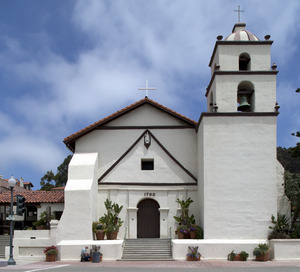
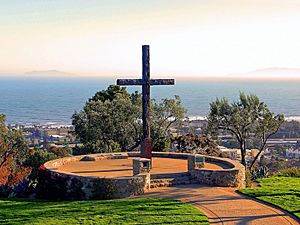
The city is officially known as San Buenaventura (Ventura) in the census. In 2020, Ventura had a population of 110,763 people. This makes it the 4th largest city in Ventura County.
Most people in Ventura are White, but there are also many people of Hispanic or Latino background. There are also smaller groups of Asian, Black, and Native American people. Ventura is a diverse city with people from many different backgrounds.
Ventura's Economy: How People Make a Living
Ventura is a popular place for tourists. Its historic sites, beaches, and resorts bring many visitors. Businesses related to tourism, like hotels and restaurants, are a big part of Ventura's economy.
The company Patagonia, which makes outdoor clothing, is based in Ventura. Another company, Petunia Pickle Bottom, which makes diaper bags, also started here.
The city created the Ventura Ventures Technology Center in 2009. This center helps new technology businesses grow. It aims to create jobs and attract new companies to the area. The Trade Desk, a big company in online advertising, started in this center.
Who are the Biggest Employers in Ventura?
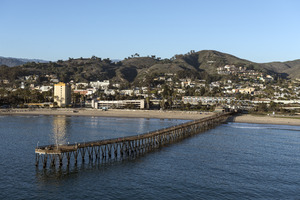
Here are some of the largest employers in Ventura:
| # | Employer | Number of employees |
|---|---|---|
| 1 | County of Ventura | 8,232 |
| 2 | Ventura Unified School District | 2,650 |
| 3 | Community Memorial Health System | 2,176 |
| 4 | Employer's Depot Inc. | 820 |
| 5 | Patagonia Works | 665 |
| 6 | Kaiser Permanente | 656 |
| 7 | Ventura County Community College District | 653 |
| 8 | City of San Buenaventura | 615 |
| 9 | Target | 495 |
| 10 | Ventura Superior Court | 305 |
Arts, Culture, and Fun in Ventura
Where Can You Hear Music in Ventura?
The Ventura Theatre is an old building downtown. It has hosted many famous musicians like The Doors, Pearl Jam, Van Halen, and Johnny Cash. Local artists also perform there.
The Ventura County Fairgrounds is where the annual Ventura County Fair takes place. It has also hosted concerts with bands like Jimi Hendrix and The Grateful Dead.
What Can You Do in Downtown Ventura?
Downtown Ventura is a lively area. It has the Mission San Buenaventura, museums, art galleries, restaurants, and shops. The historic Ortega Adobe is also downtown. It was once home to the Ortega family, famous for their chili products.
You can find many restaurants, wine bars, and breweries downtown. The Rubicon Theatre Company also performs here. In Plaza Park, there is a very large Moreton Bay fig tree.
Ventura's Libraries
Ventura has three branches of the Ventura County Library: E.P. Foster Library, Avenue Library, and Hill Road Library. There is also the Evelyn and Howard Boroughs Library at Ventura College. This library is open to college students and the public.
The Museum of Ventura County has a research library. It holds books and old documents about the history of the county.
Sports and Recreation in Ventura
Ventura is home to the Ventura County Fusion Soccer Club. This team plays in USL League Two and has won two national championships.
Ventura is famous for its great surfing spots, like Surfer's Point at Seaside Park. The X Games California event was held at the nearby Ventura County Fairgrounds in 2023.
Ventura also has the Ventura Raceway. This is a dirt track for car racing events throughout the year.
Learning in Ventura: Schools and Colleges
Ventura has several colleges. These include Ventura College of Law, Southern California Institute of Law, Santa Barbara Business College, and Ventura College. Ventura College is a community college.
Public school students from kindergarten to 12th grade attend schools in the Ventura Unified School District. The district has five high schools: Ventura High, Buena High, Foothill Technology High School, Pacific High School, and El Camino High School.
There are also private schools like St. Bonaventure High School (a Catholic school) and Ventura County Christian School.
Ventura's Infrastructure: Getting Around and Utilities
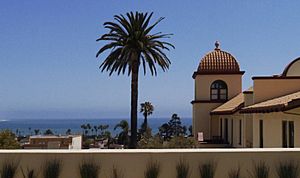
How Do People Travel in Ventura?
The main road through Ventura is the Ventura Freeway (U.S. Route 101). This freeway connects Ventura to the California Central Coast and San Francisco to the north, and Los Angeles to the south. Other state routes connect Ventura to nearby cities like Ojai and Simi Valley.
Ventura has two train stations. The Ventura–East station is the end point for the Metrolink commuter train system, which goes to Los Angeles. The downtown Ventura Amtrak Station is served by the Pacific Surfliner train.
Local buses are run by Gold Coast Transit. There are also buses that go to other cities like Santa Barbara.
How Does Ventura Get Water and Manage Waste?
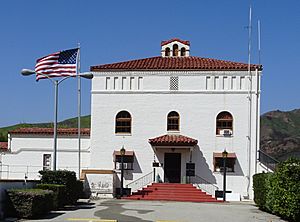
Ventura provides water to its residents. The water comes from Lake Casitas, the Ventura River, and underground water. The city has three water treatment plants, 10 wells, and 27 reservoirs.
The city also has a plant that treats wastewater. This plant has ponds of treated water that attract many birds. Some of the treated water is recycled and used for watering plants.
Ventura's Neighborhoods
Ventura has many different neighborhoods, each with its own feel. Some of these include:
- Arundell
- College
- Downtown
- Hillsides
- Hobson Heights
- Juanamaria
- Midtown
- Montalvo
- North Bank
- Olivias
- Pierpoint
- Poinsettia
- Saticoy
- Serra
- Taylor Ranch
- Thille
- Wells
- Westside
Famous People from Ventura
Many interesting people have come from Ventura, including:
- Anderson .Paak — a Grammy-nominated rapper and singer.
- Curren Caples — a professional skateboarder.
- Kevin Costner — a famous actor.
- Erle Stanley Gardner — a lawyer and writer who created the character Perry Mason.
- Kyle — a popular rapper.
- Zachary Levi — an actor.
- Cameron Rising — a college football quarterback.
- Sami Whitcomb — a professional basketball player in the WNBA.
Sister Cities
Ventura has one sister city:
 Loreto, Baja California Sur (Mexico)
Loreto, Baja California Sur (Mexico)
See also
 In Spanish: Ventura (California) para niños
In Spanish: Ventura (California) para niños


